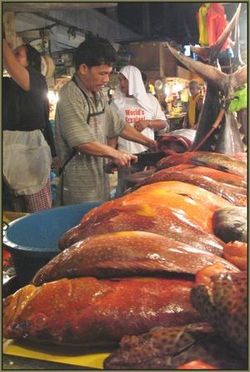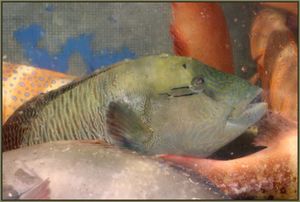Dining at a fish restaurant is a nice way to relax with friends, but it pays to makes sure your dinner doesn’t contribute to the catastrophic reduction in reef fish species numbers. Allen To reports.

Hong Kong has a huge number of fish restaurants that specialise in fresh caught reef species
Hong Kong, 6 February 2011. “What’s today’s fish special?” Imagine you’ve just entered a seafood restaurant in Hong Kong, standing in front of you are stacks of tanks. They are full of live fish of various sizes: coral trout, groupers, wrass, snapper, to name but a few. Waiters eagerly offered their insight into the quality, freshness and price of the fish, you point at your final choice and the fish are then prepared and served within half an hour.
This trade (the live reef food fish trade) occurs everyday and everywhere seafood restaurants are found. Waterfront seafood restaurants in Hong Kong, and increasingly in Southern China, have tanks almost always full of live fish. Fish in, fish out - the ocean seems to supply whatever live fish we need in whatever quantity we want.
As far as the Hong Kong Government trade record suggests, in 2009, Hong Kong retained (import minus re-export quantity) more than 8,600 tons of live marine fish, and much of this was accounted for by the grouper, snapper and wrasse species. These included leopard coralgrouper (Plectropomus leopardus), brown-marbled grouper (Epinephelus fuscoguttatus), camouflage grouper (Epinephelus polyphekadion), orange-spotted grouper (Epinephelus coioides) and mangrove red snapper (Lutjanus argentimaculatus).
So just taking the leopard coralgrouper as an example, more than 3,191 tons was officially reported to have traded in Hong Kong in 2009. This is equivalent to the weight of more than 245 double-decker buses! This immense quantity of reef fishes involved begs the question: is the supply of live reef fish sustainable in the long-run?
Surprisingly, there doesn’t seem to be a simple answer to this.
Different species of reef fishes have their unique biological features such as growth rate, age to become sexually mature and so on. This means some are more vulnerable to high fishing pressure while others may be more resilient. Also, species sourced from a well-managed fishing nations or fisheries are more likely to be facing lower threats from over-fishing.

Market demand for humphead wrasse has been large, driving down the number of this wild species
However, generally speaking, a considerable portion of live reef fish species do come with concerns on their sustainability. Humphead wrasse (Cheilinus undulatus) is one of these examples. Living in coral reefs and inshore habitats, the humphead wrasse is widely distributed throughout much of the tropical Indo-Pacific.
However the last three decades have seen a more than 50% reduction in its population. The humphead wrasse is now listed as “endangered” by the IUCN (International Union for Conservation of Nature). The main threat to the humphead wrasse would seem to be the high fishing pressure for the fish trade.
Similarly for other species, the situation is dire. The catch and export figures of leopard coralgrouper in Indonesia are reported to have dropped by 40%, while a more than 90% decline has been reported in some places in the Philippines. The squaretail coralgrouper (Plectropomus areolatus) has declined by at least 30% over the last two to three decades and is now listed as “vulnerable” by the IUCN.
It doesn’t stop there for edible reef fish. The camouflage grouper and humpback grouper (Cromileptes altivelis) are also facing threats from fishing and the latter is also listed as “vulnerable” by the IUCN. The giant grouper (Epinephelus lanceolatus) which can grow to nearly three metres has very few natural predators. Despite this, this gentle giant is also struggling for survival due to the on-going fishing pressure from the food fish trade.

Select as you wish! Live fish are displayed in tanks for hundreds of eager gourmets
Many people, especially those in Hong Kong, ask why conservationists say there is a problem. People can still order whatever fish they want despite reports of declining stocks. The answer is not numbers, but where they come from. The answer is that study suggests that we are sourcing live fish from further and further away.
In the 1970s, many of the live groupers in Hong Kong were supplied from the South China Sea and the Philippines. But by the 1980s, live groupers were increasingly sourced from Indonesia and Malaysia. And by the 1990s, this had extended to the Maldives, Papua New Guinea, Fiji, the Solomon Islands and other Pacific islands. By 2009, this had exploded and Hong Kong was sourcing live reef food fish from more than 50 countries andterritories, according to the WWF (World Wide Fund for Nature). Diners were simply getting fish from more and more distant places to fill the otherwise emptying tanks!
Emptying Tanks
Today, many reef fishes are fished faster than they can naturally replenish themselves. The result is the continuous decline of these resources, and needless to say, there could be a point when the fish become so rare in the wild and we can no longer see (and enjoy) them in our restaurants.
Consumers can shift to other seafood - those depending on the trade cannot. Within Southeast Asia, over 120 million people depend on fishery for food and income and live reef food fish are an important component.
The depletion of the reef fish resources could be a huge challenge to the food stability and livelihood of these people. Unsustainable consumption of live reef food fish deprives them of their natural resources and potential food, and also removes key species from the marine ecosystem.

Leopard coralgrouper is the single most heavily traded live reef food fish species in Hong Kong
Species in the coral reefs are intimately linked across the food chain and many of these chains are inter-crossed to form a food web. Driving species population to decline or even extinction is like playing a Jenga game where we randomly remove blocks from a tower. No one knows when the tower will fall until the block is removed.
Likewise, no one knows what species in the coral reef food web can cause an ecosystem collapse – but when species is gone, it is gone forever, and the collapse can affect the whole marine ecosystem, whether it be the productivity or recoverability of marine resources.
On a personal level, eating less reef fish can certainly benefit many overfished reef fish resources. However, the alternative is to choose only the sustainable fish. Environmental conservation organisations worldwide have published many seafood guides to help you to choose sustainable reef fishes and seafood.
For example, choosing a locally farmed giant grouper in Hong Kong is a much better choice than ordering an overfished leopard coral trout from Southeast Asia. Often, a seemingly complex environmental and social problem can come with a simple and direct solution. It just depends on whether we want to act or not.
So next time you visit a seafood restaurant and order fish, perhaps you should ask not just the price but also how much your order costs to the marine environment.
Photos by Allen To
Get more information here on sustainable seafood guides in Hong Kong and Singapore.
Download the pdf of WWF Sustainable Seafood Guide here.